We occasionally link to goods offered by vendors to help the reader find relevant products. Some of these may be affiliate based, meaning we earn small commissions (at no additional cost to you) if items are purchased. Here is more about what we do.
If you have ever eaten shrimp, you probably have come across a variety of styles: butterflied and sauteed, breaded and deep-fried, boiled, broiled, seared, grilled, roasted, and more.
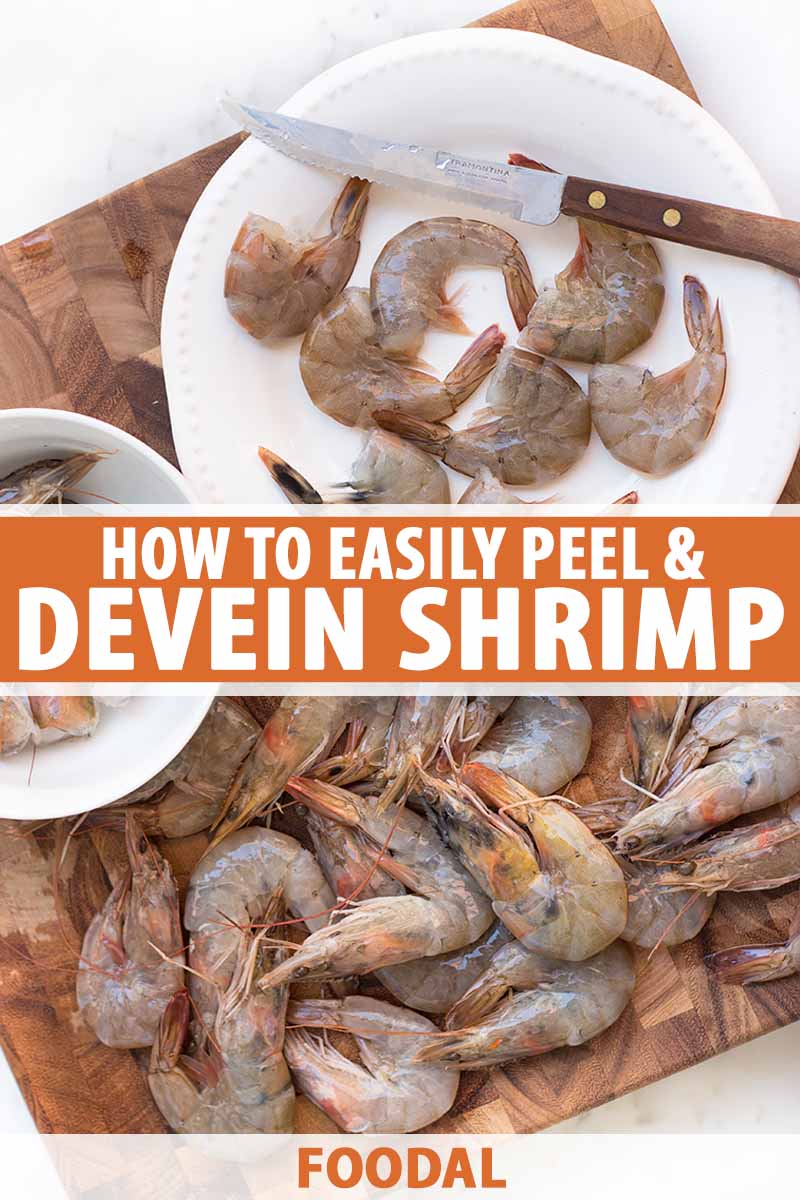
You may not realize this, but there may be a few things missing when they arrive on your dinner plate.
Very often when presented with this kind of seafood dish, the shells and digestive tracts will be removed prior to serving to make the dining experience more convenient and enjoyable for the eater.
The digestive tract is a dark, unattractive line running down the back, which is removed to make this cool crustacean both presentable and edible in a delicious array of dishes.
Some people don’t mind the digestive tract – which some mistake for or refer to euphemistically as a vein – and others insist that it be removed.
“Deveining,” or removing the guts, is also beneficial as they often have a gritty texture.
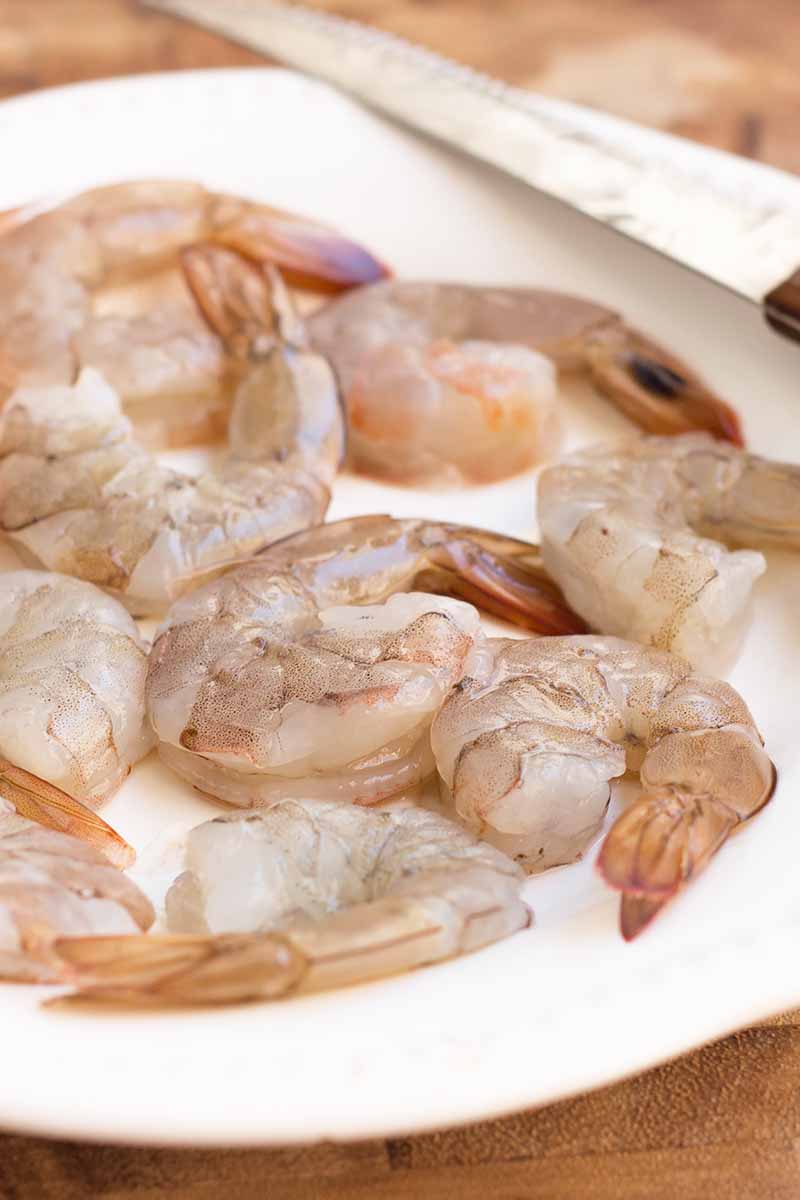
If you want to start making and serving your own shrimp dishes at home, we’ll give you our expert advice on how to prep them properly before cooking.
In the following guide, we’ll explain exactly how to clean, peel, and devein raw shrimp. All of these prep steps will also be the same if you are using prawns.
Once you get over the anxiety of facing the deveining process, you’ll see how easy it is.
With this step-by-step guide, complete with five simple steps, you’ll be comfortable with this kitchen prep procedure in no time.
How to Peel and Devein Shrimp
Step 1 – Prep
The first thing you want to do is grab a few clean dish towels or a good supply of paper towels, because your hands are going to get pretty messy.
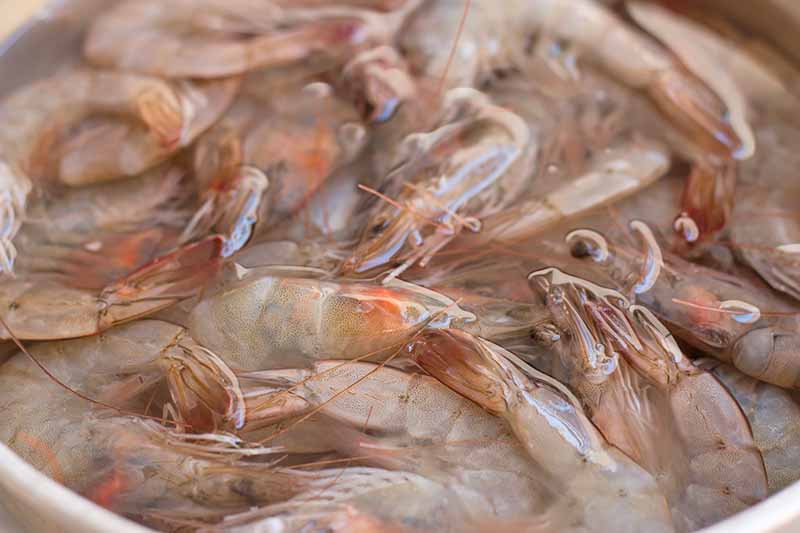
If you prefer, you can also wear disposable gloves for this process.
I also like to keep a small bowl next to my work station for easy tossing of all the scraps. And we advise placing the scraps in a trash bag and bringing that directly to the garbage can right away when you’re done!
If they are left in an open kitchen trash can that you may not take out every day, the waste will get stinky – fast – and may attract flies or other nasty critters.
Note that some people like to preserve the shells to make stock.
You will also need to set out a small and sharp knife, like a paring knife, as well as a large, sturdy cutting board. This will be your main work area, so make sure it’s clean before you begin.
You should also have a separate large bowl or plate to place the seafood on as you are working so you don’t overcrowd and clutter the cutting board.
Step 2 – Wash
Next, remove the crustaceans from their packaging and briefly wash them thoroughly under cool running water.

If they are frozen, transfer them to a colander and place it under cool running water until they are just slightly defrosted.
Step 3 – Remove Heads (Optional)
The heads and legs will usually be removed already if you purchase your shellfish from the grocery store.
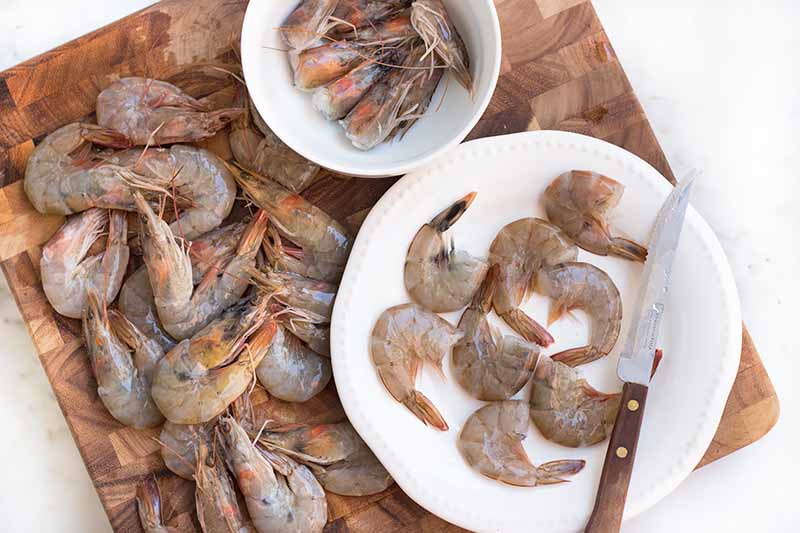
However, if you visit your local fishmonger or seafood specialty store, they may still have the heads and/or legs on.
All of the legs will be removed simultaneously in one fell swoop as you remove the shell around the body in the next step, so they can be left intact – no use trying to individually remove each one!
As for the heads, you can remove these with a quick slice of your knife, or leave them attached, depending on your preference and the presentation you are trying to achieve with your specific dish.
The heads also make a great addition to a homemade seafood stock.
When you have finished, place the prepped shellfish on a plate or in a bowl.
Step 4 – Peel
Your next step is to decide whether or not you want to leave the tails on.
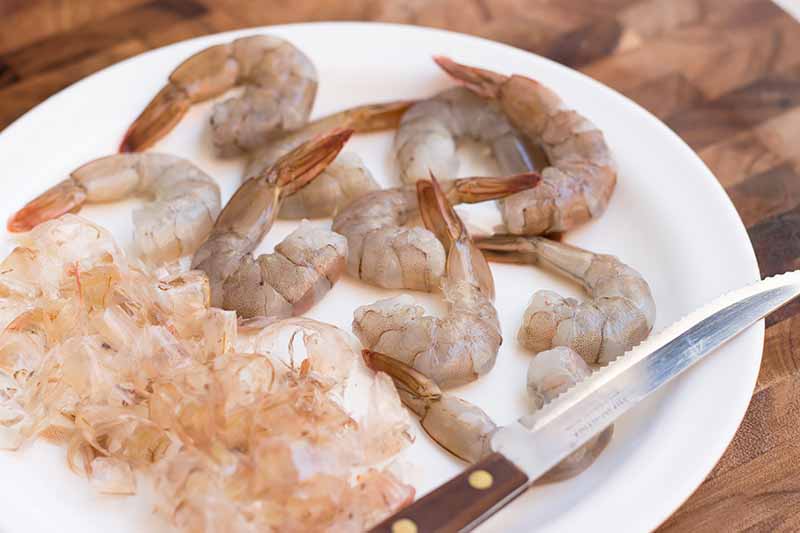
Since you are going to be peeling off the shells, you may opt to remove the tails as well.
For a nicer presentation, I suggest keeping the shell around the tails intact. Keeping the shells on around this area is especially helpful if they will be served as finger food, like for a shrimp cocktail appetizer or a large mixed seafood boil.
It really doesn’t matter where your starting point is for peeling. But if you are new at this process, I recommend starting at the top, or the head end – working in this direction will be easier.
Remove the shell and the legs up until the point where you reach the tail. Stop now to keep the shell around the tails on, or continue peeling. You get to decide.
Discard the shells or save them for stock. This is a perfect opportunity for you to repurpose your food scraps in a creative and sustainable way.
And be sure to transfer the prepped units to your bowl or plate to set the finished ones aside as you work.
Step 5 – Devein
Now we’re ready for the actual deveining process!
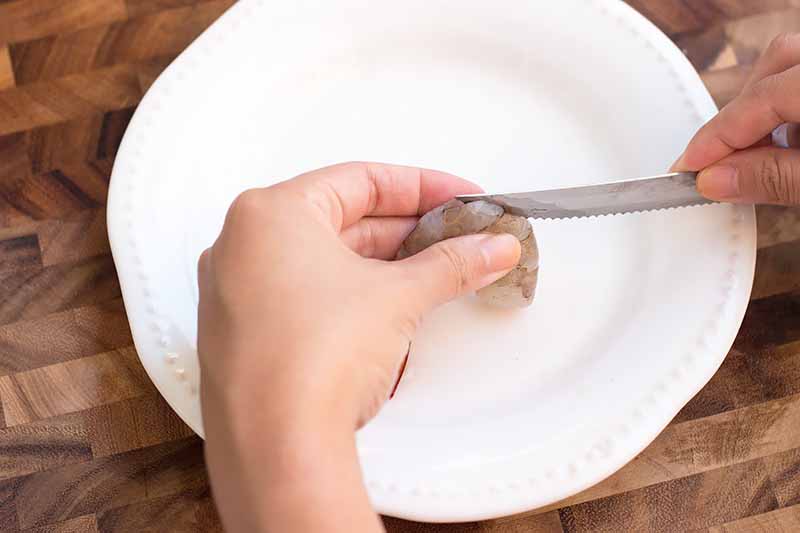
Once the shells are removed, make an incision straight down the back, following its natural curvature, using your knife.
I would say “spine” instead of “back,” but I know one of you wiseacres will probably call me out, letting me know that invertebrates don’t have spines… Ha!

You want to make the cut deep enough to expose the digestive tract.
Use the tip of your knife to carefully lift it out. Secure the tract with your thumb, and pull downward until it is completely removed.
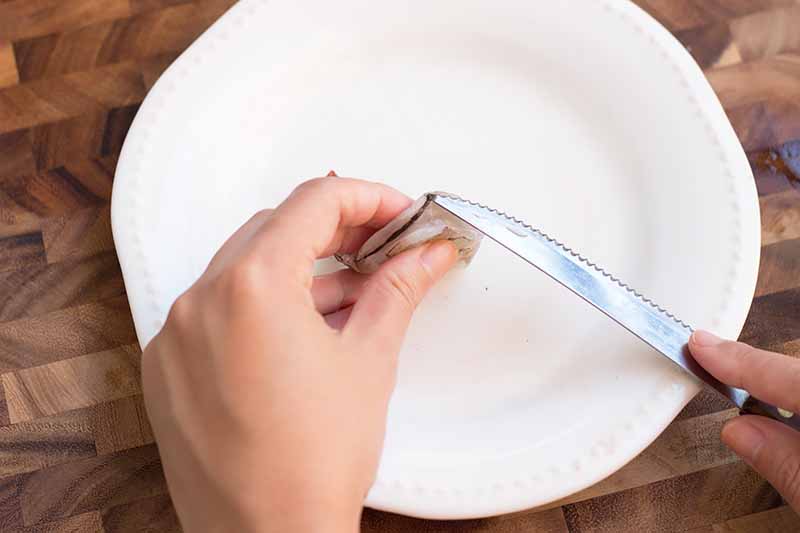
Repeat this process until all of the shellfish are clean, wiping off the prepped seafood and your hands as needed with paper towels, or rinsing under cool water.
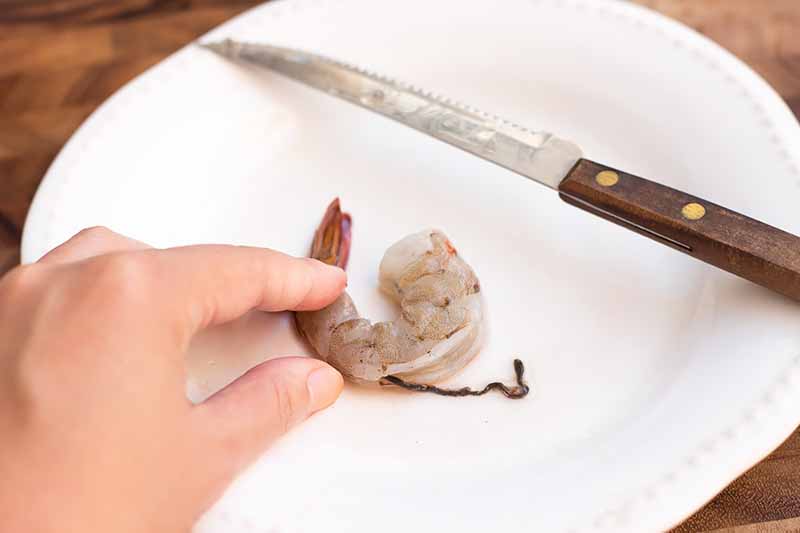
Now that I’ve explained the traditional way, I’ll also recommend a product that makes this process so much easier and faster.
This tool is the OXO Good Grips Shrimp Deveiner, which you can buy directly from OXO now, or find it on Amazon.
OXO Good Grips Shrimp Deveiner, available from OXO
Rather than fooling around with peeling and then slicing each crustacean with a knife, and then hoping that you don’t break through the black digestive tract, this OXO Good Grips device allows you to peel and devein in one swift stroke.
Simply insert the sharp, stainless steel blade between the shell and flesh at the top end of the shellfish and move it in a downward motion along the curve of its back.
I find that this tool allows me to process and prep my seafood about three times as quickly as I could if I was using the traditional method – and that’s saying a lot if you’re preparing pounds upon pounds of seafood for a large party!
Done with Deveining? Let’s Cook!
Once all the shrimp have been peeled and deveined according to the steps in our tutorial, cook according to your recipe’s instructions.
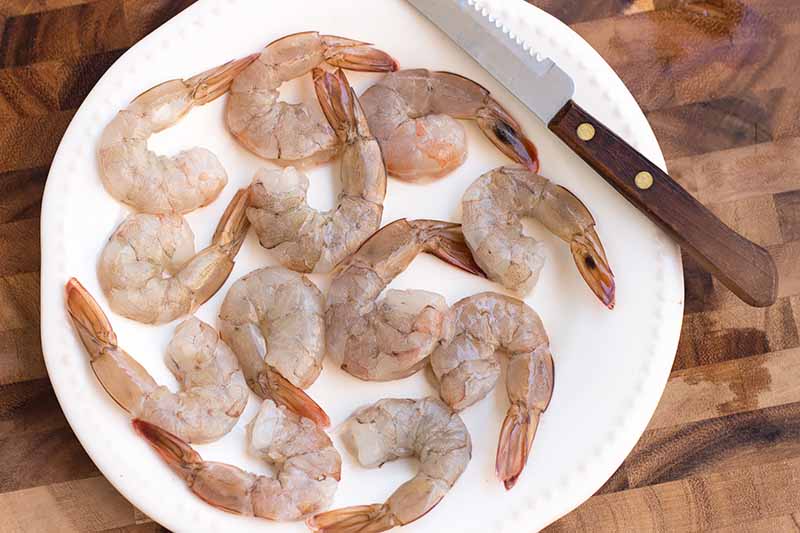
Do you prefer buying fresh shellfish and deveining it yourself? Or do you prefer to use frozen? Let us know in the comments below!
Not sure what you want to make? Now that you have your crustaceans prepped and ready, here are a few shrimp recipes to inspire you:
Photos by Felicia Lim, © Ask the Experts, LLC. ALL RIGHTS RESERVED. See our TOS for more details. Product photo via OXO. Originally published on September 3, 2014. Last updated on June 21, 2023. With additional writing by Felicia Lim and Allison Sidhu.
About Nikki Cervone
Nikki Cervone is an ACS Certified Cheese Professional and cheesemonger living in Pittsburgh. Nikki holds an AAS in baking/pastry from Westmoreland County Community College, a BA in Communications from Duquesne University, and an MLA in Gastronomy from Boston University. When she's not nibbling on her favorite cheeses or testing a batch of cupcakes, Nikki enjoys a healthy dose of yoga, wine, hiking, singing in the shower, and chocolate. Lots of chocolate.

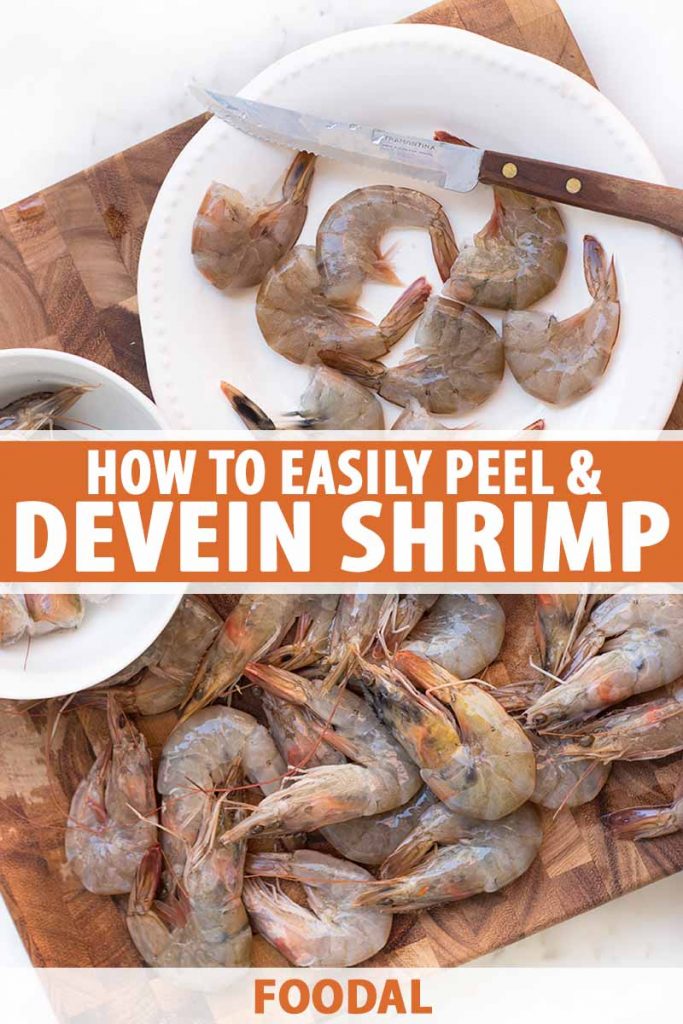
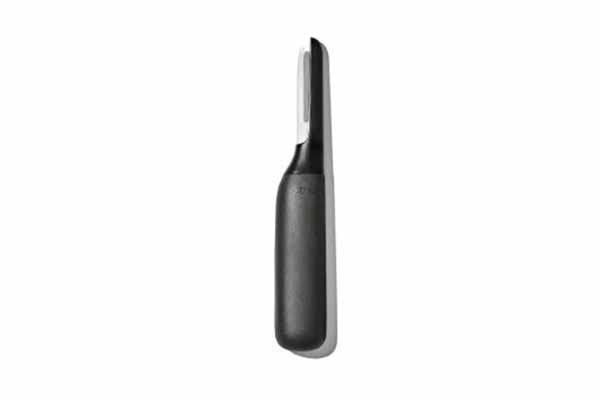

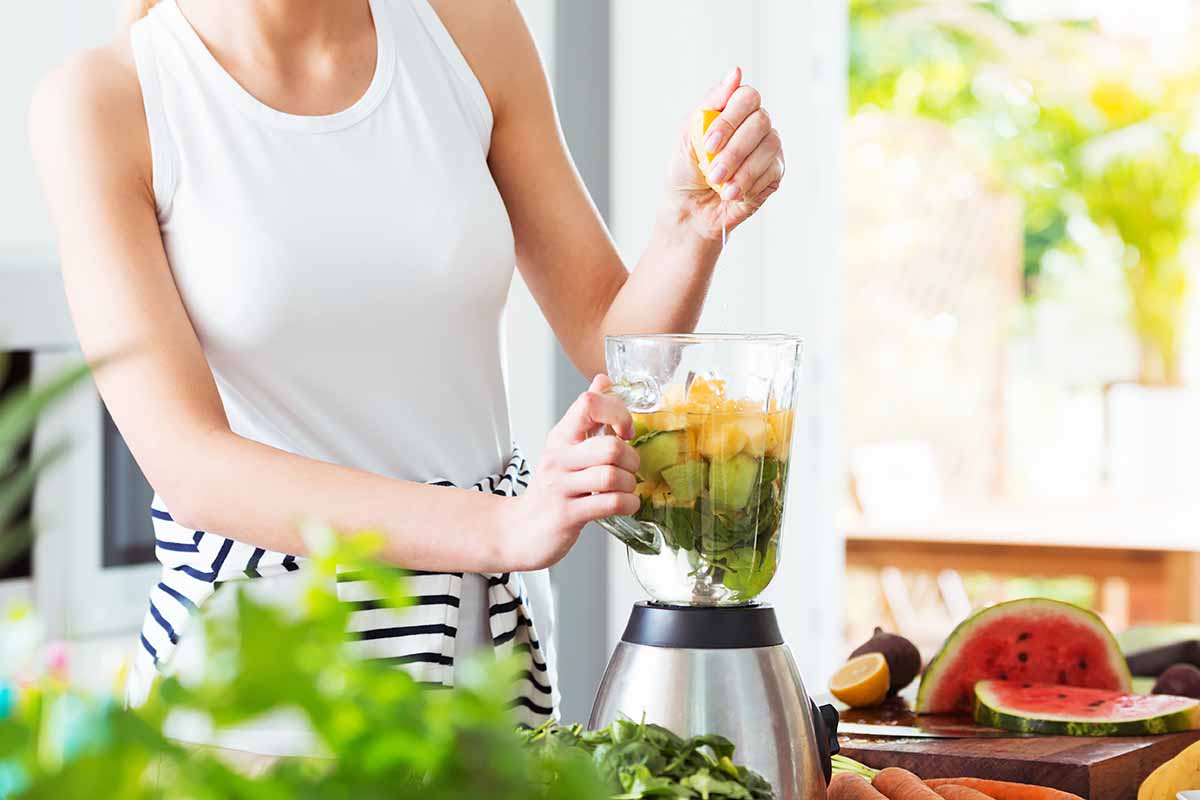

That shrimp cleaner sounds like a very handy gadget. I live on the gulf coast where shrimping is a way of life, so I have deveined my fair share of shrimp. Deveining shrimp is one of the least enjoyable tasks ever. Anything that will make the process easier is more than welcome as far as I’m concerned.
That makes two of us! I have done it so much and so long I think I could do it in my sleep. I’m going to look into finding that gadget.
You have explained the process well. I love seafood and have shrimp like this 4-5 times a year. It is a little messy and takes some getting used to , but you cannot beat the taste of freshly peeled and cleaned shrimp!
Only 4-5? You’re so fortunate. My family thinks they wants shrimp and crabs at least 5 times a month. I’m always always peeling and deveining.
I used to buy giant bags of freshly caught and cooked shrimp directly from the fishermen at the docks. One of my most treasured memories of childhood vacation at the beach. Didn’t need anything more than my hands to peel them and eat them, though!
Am at a loss…never eaten shrimp…just wondering how they taste like…the closest to seafood i have gone, is prawns with cashew nut sauce…boy, wasn’t that heavenly…i ought to try out shrimp, really ought to.
This is one of those things that if you have roots around shrimping waters then you are used to it. I think our family has shrimp at least once or twice a week. I know in the summer time when we grill there are always some shrimp on skewers or tossed in a grilling seafood pan with some spices and butter. Older versions of the shrimp cleaner can be found in many chef and cooking stores along the deep south as well as in Wal-mart, seafood shops and at boat ramps with fresh seafood shops, catch of the day type places. My granddaddy had one made of an old kitchen knife and the handle was a wad of tape holding the wood in place. What great memories this simple post stirred up.
Fantastic tips. I always make sure to check my shrimp when I get Chinese food. That’s how you really know the quality of the place you’re eating. It seems like when they use smaller shrimp they don’t feel the need to devein them & that’s just gross to me.
I love eating shrimp so much, it’s pretty much my favorite food. I have been unaware this whole time that they have to be ‘deveined’, it sounds so gross! Ha-ha. I have never prepared it myself, I’ve only eaten it at Chinese restaurants. I guess it is a good thing I check your blog, now I know.
Even after this discovery, I still love shrimp just as much. I just don’t think I want to prepare it.
I know it’s shameful but I have never eaten shrimp in my entire life. It seems really good and I’d like to try it sometimes but I never got the chance.
It seems like a tedious process to prepare it at home so I think I’m going to go to a restaurant. Great article though!
I have eaten my share of shrimp, but have never cooked shrimp that hasn’t already been deveined. That being said, I didn’t realize until recently that the ‘vein’ was actually the digestive tract, and I didn’t understand the big deal about removing it. So, when I saw your article, it caught my eye. Since I live along the coast, and have fish markets nearby, I’ve been thinking about buying some fresh shrimp for a stir fry, and the OXO Good Grips Shrimp Cleaner sounds like just what I need to get me started!
I love eating prawn, but prepping and cooking it? Not as much. Though, this article has made it seem much less daunting. I think I may have to hit the shops and grab a bag! And that de-veiner seems like a nice investment, if I decide to cook seafood more often. It might not be necessary, but there’s a lot to be said for comfort! (And not being covered in shrimp intestines.)
You have successfully made this process seem, at least somewhat, easier. I’m always so intimidated by this task, I typically buy crappy frozen shrimp that is already cleaned. Doing that doesn’t allow me much creativity in preparing recipes. For the most part, I just eat them when I’m dining out. I think I’m going to have to buy some quality prawns very soon so I can try this process out!
I remember the first time I had to peel shrimp it was so fun. I don’t recall deveining them however. This has been years ago. I still love peeling them, and now I also devein them. Shrimp are so tasty anyway they are cooked. I do like the fried version better then the rest.
I’m so happy I found this because I always make a mess when I try to clean and prepare prawn. I think that my mistake was not using the proper knife. I’ve always used a regular sized knife, and now that you mentioned a small knife is better I understand why my shrimps were always deformed. Great article, thank you!
I’m glad I read this. I have never really known the proper and thorough method of de-veining. Nothing ruins my appetite like seeing a plate of seafood that has not been properly cleaned. That little tool is amazing. I need to get one, so I won’t be so intimidated about serving shrimp.
This is a nice short article that is concise and to the point. I’ve never been a fan of deveining my shrimp. That isn’t to say I don’t do it, I definitely do but I hate how much time it takes. I don’t make shrimp much because of it. I know many people would just tell me to buy the frozen ones that are already deveined but I hate buying frozen seafood. I prefer to get it fresh if possible. Hopefully this knife will speed up the process a bit.
I hate taking the vein out. If it’s just myself I will just leave them in, does not bother me.
Wife will not eat then unless they are deveined (she will always notice, you would be surprised at how many restaurant don’t take the vein out.)
$7 for a specific tool to do this? Sold! Take my money! Hopefully going to find one in stores this week.
This article is so much help! I love shrimps, but peeling and deveining them is such a pain! To be honest, I’ve never bothered to find out what that dark line on the back was but I’ve always removed it anyway (which is quite a difficult task). I’ll try the technique you’ve explained in this article. I hope this will make the process easier. Of course, the most effortless way would be to buy frozen praws but they aren’t nearly as tasty as fresh ones.
Just out of curiosty, when you de-vein shrimp, do you do it mostly for taste, texture, or appearance?
I found this article very interesting because de-veining shrimp isn’t common here. As you said, it isn’t really a European thing. Even the prawns we can buy pre-shelled and pre-cooked in the supermarket usually still have the veins in, and I have many fond memories of sitting on the beach with a half-pint of prawns, whipping the shells off and eating them without de-veining. It doesn’t really change the taste, although it can add a gritty texture.
While larger shellfish are always de-veined, the only time I have de-veined shrimp was when I was butterflying them, both because it is easy as part of the process, and because removes an unsightly dark line that can be found after cooking otherwise.
Well it can certainly be a messy experience, but it is a necessary one. I am one of those people who do not really mind the tract, but of course it is still a little unnerving and I would prefer to have it out of there. I think that I just have gotten into my own routine of getting it done and I cannot say that I really have any technique, outside of a little sewing tool that I use in the kitchen to help. Other than that it just takes some patience and good focus. Thanks for sharing.